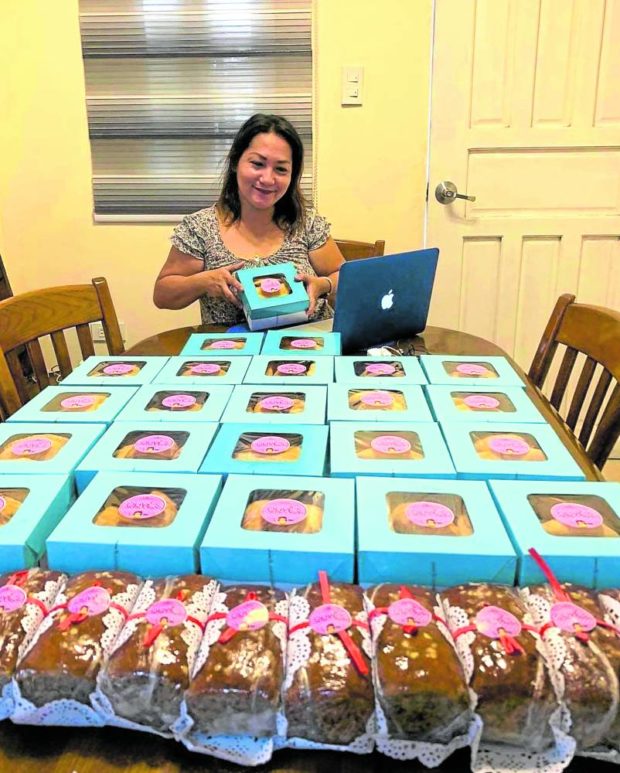THRIVING Olive Sevilla of Olive’s Cakeroonery preparing her baked goods for delivery to customers. —Contributed photo
My family orders from food entrepreneurs at least two to four meals weekly, sometimes even more frequently. We want to support entrepreneurs as well as the economy. In fact, I released a four-minute free video “Business Model Map for Food Delivery Business” on YouTube to help these entrepreneurs understand the bigger picture. Many have thanked me for the tips that have helped them gain new ideas to improve their business.
Here are some things that food ‘homepreneurs’ may want to pay attention to.
1. It is not food alone that matters. Service, experience and image are equally important. You can have the most delicious food, but if the service inquiries are not handled promptly and properly, if delivery schedules are mixed up, or if customer experience is bad (such as when the food arrives one to 1.5 hours late), if no apologies are given and no customer recovery is done, then the image as a reliable supplier will be gone and there will be no second chance for a good first impression. It is worse if the food taste is ordinary and lower in quality than what was described or photographed!
2. Remove any consumption barrier. Requiring customers to book riders on their own may lose you time-starved customers who don’t want to deal with processes with riders.
3. Make it worth the customers’ effort. If a vendor has no choice because it lacks manpower and is unable to cook and deal with riders at the same time, make it worth the customer’s extra effort by having a really super delicious food that loyal customers would recommend. An indicator is when there is a long queue of people waiting for their next availability. My son Calel (@calelg), for example, posts on Instagram to praise those doing a good job in food quality.
4. Be flexible. If you have a product that is good for six to eight people, can you allow half orders for smaller families and to expand your customer base? It would be difficult to wait for customers to ask for these possibilities, so mention sizes upfront.
5. Make it convenient. Sending customers a poster advising them how to pay a vendor is not as convenient. Making customers write payment details on a separate piece of paper and then encoding the payment can be avoided by simply sending a text message, so that customers can simply cut and paste account numbers when paying.
6. Anticipate potential problems. If a vendor lives inside a posh subdivision or the customer’s address is a known ‘class A’ subdivision with strict security where riders need to fall in a long line going in and out, vendors may want to offer tips to be prioritized by riders, and at least give consideration to the time and opportunity lost by the riders. Alternatively, they may want to have special arrangements with some riders during peak days and time. After all, riders are the link between the customers and the vendor. A tip in exchange for being a reliable supplier is a good tradeoff.
7. Be a solution provider, not problem giver. Passing on to the customer the task of booking a rider after a vendor has accepted prepayment for food and delivery is unprofessional. On the other hand, I have encountered a burger supplier who decided to drive himself to deliver when no rider was booked. The first one tried to transfer the problem to the customer; the second one provided a solution.
8. Communicate. While advising customers that delivery is on the way is a standard procedure, add a reminder that the rider has already been paid. A few riders still insist they have not been paid and want us to pay the delivery fee. This adds unnecessary handling cost to the customers.
9. Consistency and continuous improvement are key. If the food quality is great, make it consistent. Avoid experimenting with paying customers when products are not ready for launch. Better manualize recipes with photos of final products in case another cook needs to be involved in preparing the same food.
10. Think of a repeat purchase cycle. Instead of waiting for inbound orders, outbound prompts can also be added. A leave-behind menu, an email reminder, a discount or freebie on the next purchase and similar activities may help improve volume. —Contributed
Josiah Go is chair and chief innovation strategist of Mansmith and Fielders. He specializes in the areas of market-driving strategy, profit strategy, business model and innovation.
Read Next
Subscribe to INQUIRER PLUS to get access to The Philippine Daily Inquirer & other 70+ titles, share up to 5 gadgets, listen to the news, download as early as 4am & share articles on social media. Call 896 6000.
For feedback, complaints, or inquiries, contact us.
For all the latest Business News Click Here
For the latest news and updates, follow us on Google News.

